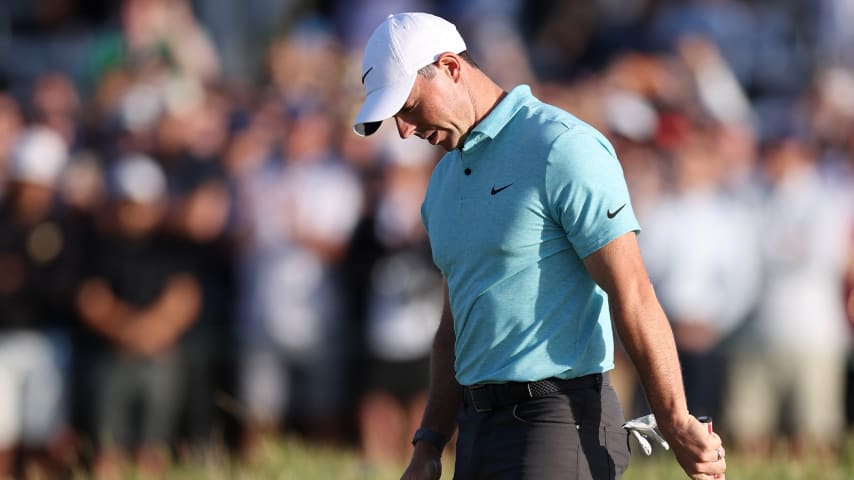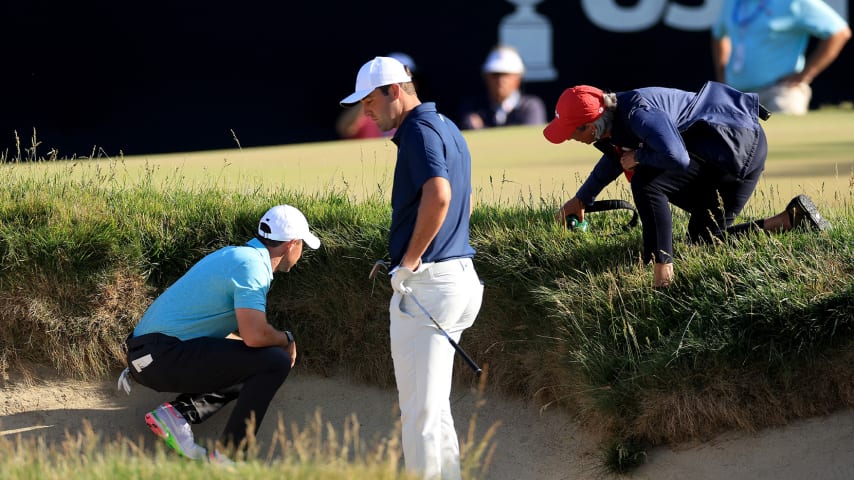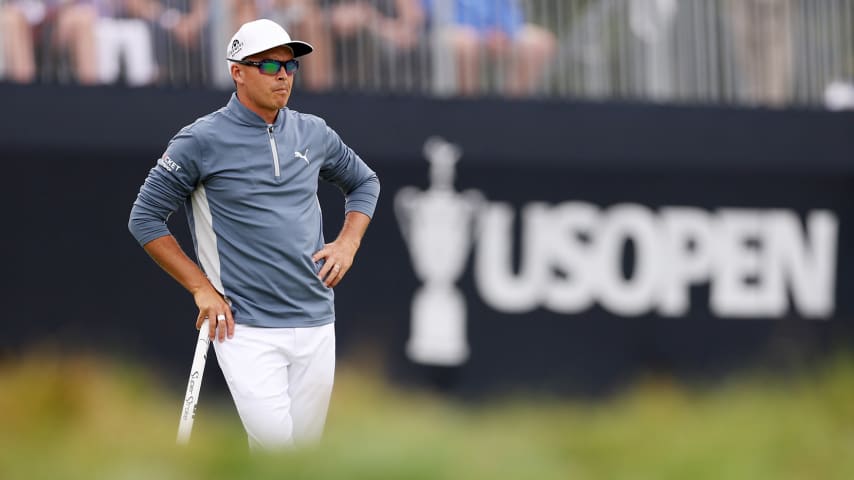Rory McIlroy endures another close call at U.S. Open
6 Min Read

Written by Sean Martin
LOS ANGELES – Rory McIlroy was flanked by two police officers as he walked off The Los Angeles Country Club’s 18th green. He passed the white, one-story clubhouse and a row of roses before striding between two metal barricades standing sentry outside the scoring trailer. His hat cocked atop his head at a 45-degree angle, he stared at the ground as he walked. Then, as he passed into the relative solitude of this restricted area, he slightly twisted his head and pursed his lips in that way people do when they want to quietly express dismay and disappointment.
McIlroy’s caddie, Harry Diamond, and longtime agent, Sean O’Flaherty, trailed behind. This procession had a funereal feel. McIlroy went inside to sign his scorecard and watch the leader, Wyndham Clark, play the final hole. A few dozen rubberneckers stared silently through the clear plastic doors, witnessing an unvarnished display of emotion.
The final group still had one hole to play in the U.S. Open but any sensible person knew the probable outcome. Clark, 29, had won just once previously on the PGA TOUR but played Sunday like someone impervious to the pressure. He did what U.S. Opens demand, continually grinding out pars, and the final hole was no exception. He displayed the sort of mettle that was expected from the stars who could not catch him.
Clark parred 18 for a 70 on Sunday, the same score shot by his closest pursuers. McIlroy finished second by a stroke while Scottie Scheffler finished alone in third, three shots behind the champion.
Inside the temporary tent, McIlroy was secretly hoping for a mistake from the man he had chased all day. “You're rooting for one guy, and that guy is yourself at that point,” McIlroy admitted.
But when Clark lagged his 60-foot birdie putt within inches of the hole, McIlroy knew the long-awaited win wasn’t coming. The assembled media watched in silence as O’Flaherty listened to McIlroy’s post-round interview schedule. McIlroy stood next to him, staring unblinkingly at the ground. He did the same after climbing a few steps onto the platform where Cara Banks waited for him. The conversation before such interviews is usually genial and full of small talk, but the pair did not utter a word as they waited somberly for the camera’s red light to illuminate.
From there, McIlroy walked to the interview tent. The most telling comments are often said away from the microphone and as McIlroy climbed the steps toward the podium, he turned to O’Flaherty and said, “It was St. Andrews all over again.”
It was a brief comment that didn’t need further explanation. This was another major that had slipped away after the approach shots didn’t settle close enough to the hole and the long birdie putts slid agonizingly by.
The Los Angeles Country Club does not carry the spiritual significance of the Old Course, the only venue other than Augusta National where McIlroy most desires a win. But that did not make this loss any less difficult. Instead of the ancient stone buildings where Old Tom Morris had once sold his wares, the skyline encircling LACC’s 18th green is interrupted by brutalist apartment buildings built of concrete and glass. Winning at St. Andrews carries extra weight because it is a feat accomplished by generations of golf’s greats. This was the first U.S. Open ever played at LACC.
At St. Andrews last year, McIlroy hit every green but made just two birdies in the final round, losing to another player in his late 20s having a career-changing season. Cameron Smith shot 64, including five birdies at the turn, to add The Open to THE PLAYERS title he'd won earlier in the year. McIlroy didn't make a bogey that day but also had 36 putts.
Despite consternation about low scores at the start of this U.S. Open, the final round stayed true to the tournament’s trademark toughness. Pars were not penalizing, especially for players in the final groups. McIlroy started the day just one stroke behind the co-leaders, Clark and Rickie Fowler, and made just one bogey. That usually leads to success, but McIlroy also made just one birdie. The back nine was a showdown between McIlroy, perhaps the greatest player of the generation, and Clark, who was ranked outside the world’s top 100 just three months ago and earned his first PGA TOUR victory at the Wells Fargo Championship in May. But Clark did not falter and McIlroy could not pass him.
McIlroy hit 15 greens on Sunday at LACC, tied with Jon Rahm for the most in the field. McIlroy’s average proximity of 35 feet was 11th-best in the field and he ranked 15th in Strokes Gained: Approach-the-Green in the final round (+1.0).
“I played the way I wanted to play,” McIlroy said.
But like St. Andrews, he did not give himself enough birdie opportunities and did not capitalize on the ones he had. His 34 putts were the second-most in the field and he lost more than two strokes on the greens. The longest putt he made all day was 7 feet, 3 inches. Only three players failed to make a longer putt in the final round.
McIlroy had just two birdie attempts inside 10 feet all day. One was his 1-footer to complete a two-putt on the short par-5 opening hole, his lone birdie of the day. The other was a 4-footer on the front nine’s other par-5, the eighth hole. He missed that one, shooting just 1-under 34 on the front despite hitting eight greens.
He followed his miss on No. 8 by missing birdie putts from inside 20 feet on the next three holes. There were two shots that McIlroy said after the round that he wished he could attempt again. One was the short miss on the eighth hole. The other came on the back nine’s lone par-5. With 110 yards left to the hole, McIlroy missed the green and his ball buried in thick grass lining a bunker. It had been an ideal yardage for a sand wedge. Until the wind picked up. He tried to hit a soft gap wedge instead.
“I feel like I didn't time the shot perfectly,” he said. “I hit it when the wind was at its strongest and the ball just got hit a lot by the wind, and obviously it came up short. If I had it back, I think I had the right club and the right shot. I might have just had to wait an extra 15 or 20 seconds to let that little gust settle.”
It set off a frantic search for his ball, which had embedded in the ground. He was given a free drop but still unable to save par. The bogey, his lone of the day, dropped him three behind Clark.

Rory McIlroy and Scottie Scheffler by the 14th green during the final round of the U.S. Open. (David Cannon/Getty Images)
McIlroy was one back after Clark’s bogeys at 16 and 17, but McIlroy’s 40-foot birdie putt at the last slid by the hole. After winning four majors by the age of 25, it has now been nine years since McIlroy’s most recent major win. He has six top-10s in his past seven majors, including two runners-up and a third-place finish. They are cruel reminders of golf’s slim margins, ones that can only be endured with hope.
“I would go through 100 Sundays like this to get my hands on another major championship,” McIlroy said.
Then he stepped off the podium.






